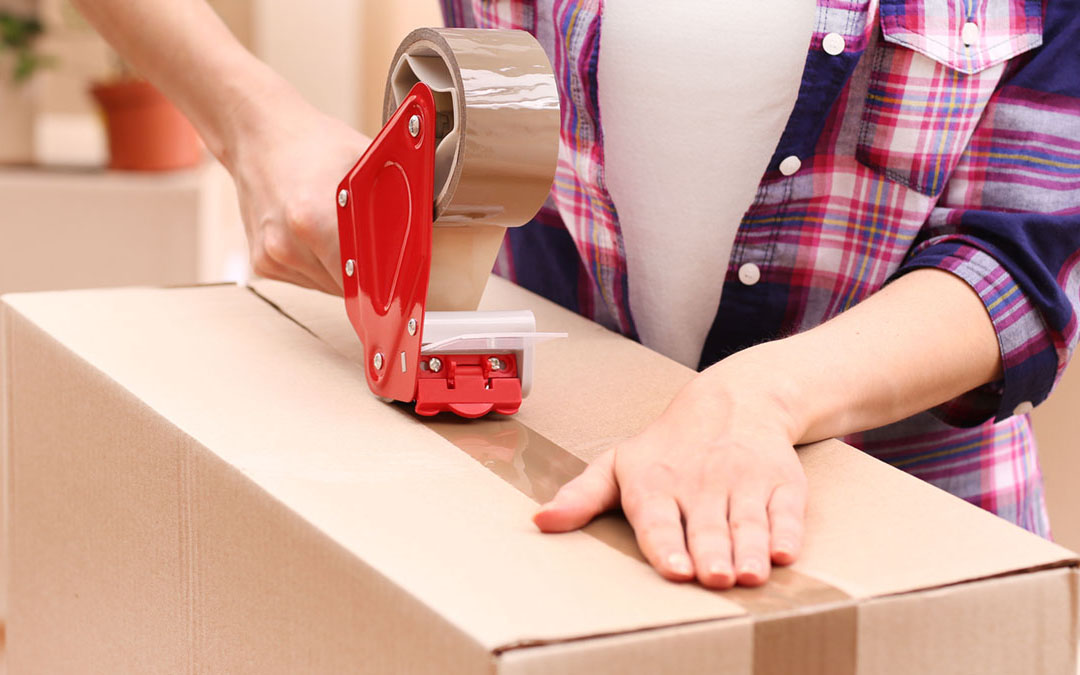We know what you’re thinking—you already know how to close a box. And, of course you do. All it takes is some tape and you’re ready to go. But there are times when good old carton sealing tape might not be your best bet. Or you’re out of the sticky stuff and need another option while in a packaging pinch.
Here’s 5 ways you can close a corrugated box with or without tape.
How to Close a Box: Packing Tape
The gold standard. Cut two pieces from a roll and seal the bottom and top flaps closed. It gets the job done and will always be a great option. Depending on what you’re selling or where it’s going, you’ll want to choose packaging tape that handles certain conditions.
Water activated tape bonds to a corrugated box once dry and is impossible to remove with tearing it. This makes it ideal for shipments that might be prone to tampering. And cold temperature tape has an adhesive that remains tacky in lower temperatures. It’ll stand up better in wintry conditions where regular carton sealing tape may fail to keep a box closed.
You can also try a technique called the H-tape method. This involves not only taping the flaps closed, but covering over the exposed sides of the flaps as well. This provides even more stability and security to a sealed box. And it keeps dust out (something desirable during moving or long-term storage) while helping to keep the inside of a box cooler or drier (ideal for shipping food or other perishables).
Whatever you choose, be sure to pick up hand held tape dispensers. They not only speed up your packing efforts, they waste less tape and provide a tighter seal.
How to Close a Box: Stretch Wrap
This is an unconventional way to close a box and it’s not one to use for shipping something. But, if you’ve run out of the sticky stuff, it’s a temporary solution that works well enough in a pinch. Whether you’re moving to a new place or packing a product skid, you’ve at least got something to keep that box closed during an easy trip.
What makes stretch wrap a viable last-resort packing option is that it gets its strength and security from the application of tension. Pulled tight and wrapped in a few layers, the pre-stretched film will compress and hold that box of silverware closed well enough to make it to your new kitchen.
Stretch film can even be twisted into rope that can be tied around something to secure it. You’ll often find that technique used on loaded skids, or products grouped on a pallet. Whatever you decide, ensure the film holds tight—and then go get some more rolls of packing tape, pronto.
How to Close a Box: Custom Labels
This one’s more about contributing to the look and feel of a product’s packaging—or acting as the finishing touch on customer orders. A label placed across a closed flap acts as a seal. It means the package you hold in your hands was personally packed and sealed by someone who cares. It also means that package is meant just for you. Breaking the seal isn’t meant for someone else.
Our custom labels are made from high-quality vinyl and adhere exceedingly well to corrugated boxes. They’re meant to be used in conjunction with packaging tape (custom packing tape will really make your packaging look slick!), closing the box securely and branding it brilliantly.
How to Close a Box: Strapping
Commonly used for securing pallets, strapping is sometimes wrapped around particularly large or heavy shipping cartons (automotive parts, we’re looking at you). This reinforces the walls, secures the closures, and honestly, looks pretty cool.
Fun fact: it’s also used to bundle flat, unbuilt boxes together.
Strapping can be made from several materials, including steel, polypropylene, polyester, nylon and even paper. If you use it to close a box, you’ll want to choose the right style for your needs (for example, steel may be overkill for toiletries, but paper may not be reliable enough). You’ll also want to ensure you tighten your strapping to the right amount—too loose and it won’t secure anything, too tight and you may begin to damage your products. As with most things, moderation is key.
How to Close a Box: Front Lock Mailers
Here’s a box that doesn’t necessarily need tape to close it. Front lock mailers, also known as tuck top boxes or e-commerce boxes, are designed to be folded and locked into place, creating their own stability and closure. They’re stylish and compelling packaging, ideal for showcasing high-end products and creating memorable unboxing experiences.
Using packaging tape to seal front lock mailers is a good idea if you’re using them as shipping packaging. They’ll switch hands a lot during delivery, and you’d like to ensure everything inside stays inside. A custom label across the front closure is an attractive finishing touch.
Corrugated boxes are chosen for shipping products (and customer orders) more than any other style of shipping carton. As such an oft-used piece of packaging, the techniques on how to close a box are definitely worthy of attention. Whether shipping out your Kickstarter product or wrapping up that last box of clothes you forgot about, you’ve now got plenty of box sealing options in front of you.




